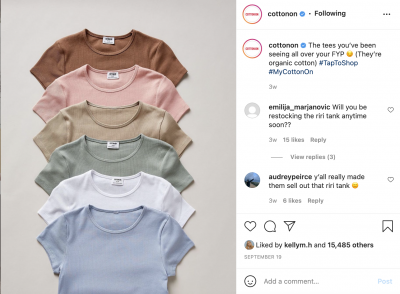Sustainability in Fast Fashion:
Contradicting or Achievable?
Fast fashion is quickly becoming a popular term thrown around in society as a criticism for retail companies and outlets who are perceived as being “unsustainable” in their practices. But recently, many fast fashion companies have implemented measures to appear more sustainable and lessen their carbon footprint. However, it then poses the question: can retail companies really achieve sustainable fast fashion, or is the idea just contradictory?

What is fast fashion, and why is it bad?
Fast fashion can be summed up in three key terms: cheap, trendy and over-produced. Fast fashion finds inspiration from cat-walks and high-end retail stores, but then reproduces garments at a faster rate and a lower quality to meet consumer demand (Rauturier, 2021).
The concept of “outfit repeating” is a taboo topic in society as mainly teenagers and young adults stray away from wearing the same outfit multiple times, or more importantly, being spotted in the same outfit more than once. The faux pas nature of outfit repeating has fuelled the success of fast fashion and encouraged over consumption and consumerism. Fast fashion companies thrive on society’s undying need to buy a new outfit for every occasion and get rid of perfectly good clothes simply because they are out of season or no longer trendy (Rauturier, 2021).
The fashion industry today produces more than 400% the amount of garments made 20 years ago. Every year, the fashion industry produces 80 million garments, equating to more than 10 for every person on earth. Fast fashion is said to be unsustainable due to its negative environmental impact notably through levels of water usage, microfibres, greenhouse gases, deforestation, toxins, and human rights inequalities (Young, 2021). Here are some specific and concerning facts about the harmful effects of fast fashion:
- 85% of all textiles go to the dump every year.
- 31% of plastic pollution in the ocean is composed of microplastics.
- 10% of all humanity’s carbon emissions is produced by the fashion industry.
- 20% of all industrial water pollution worldwide is caused by the fashion industry (McFall-Johnsen, 2019).
How can you spot a fast fashion company?
You may be wondering, how can you actually distinguish between a fast fashion company and a sustainable fashion brand? Here are some factors to keep an eye out for:
- Thousands of styles which fit in with all all the latest trends.
- Offshore and outsourced manufacturing from countries with the cheapest labour without proper consideration for fair wage requirements and adequate rights or safety.
- Cheap, low-quality materials that are likely to breakdown and degrade easily.
- A limited availability and quantity of certain garments to create the perception that if the customer does not buy something it will not be there next time (Bosco, 2019).
Where did fast fashion come from?
Fast fashion definitely has not always been around, and hasn’t actually even been around for that long. Let’s look back on the history of fashion and the origins of fast fashion:
1800’s:
The Industrial Revolution introduced new textile machines, factories were able to produce on-demand clothing and large quantities of products in a range of sizes. Manufacturing moved away from made to order and towards bulk production. The patenting of the sewing machine allowed for an extreme price drop for clothing and an increase in the scale of clothing manufacturing (Idacavage, 2018).
1900’s – 1950’s:
The 20th century still saw large amounts of clothing production being done in homes or small workshops despite the growing number of factories. World War II called for more standardisation in all clothing production and resulted in middle-class consumers becoming more receptive to the value of purchasing mass-produced clothing after the war (Idacavage, 2018).
1960 – 2000’s:
In the 1960s young people embraced cheaply made clothing to follow new trends and reject sartorial traditions of the generations before them. In response to growing demand for affordable clothing, large scale textile mills opened across developing countries and presented the opportunity for outsourcing labour while implementing cost-cutting measures (Idacavage, 2018).
Case Study

Cotton On is a popular and large global fast fashion brand that has actively strived to operate more sustainably and has implemented various strategies and programs to reduce their carbon footprint and negative social and environmental impacts. Cotton On’s sustainable initiatives include going carbon neutral; reducing, re-using and recycling plastic they use; saving water by driving water reduction technology and conservation methods; and sourcing responsibly by using sustainable cotton and viscose and other materials (Cotton On Group, 2021). On their website they have a section dedicated to their sustainability story and their commitment to improving their practices. On the home page of their sustainability section, they say:
“Making a positive difference? It’s what we’re all about. And when we’re talking sustainability, we’ve made some impacts so far that we’re really proud of. But we know there’s more to be done. And, we’re taking action. ‘Cos we know our future depends on it. We’ve got big goals for our packaging, our product offerings – swim, puffers, denim, tees and so much more – and across our entire operations” (Cotton On Group, 2021).


Is sustainability achievable in fast fashion?
As discussed earlier, fast fashion originated from the need to implement cost-cutting measures in response to greater demand for affordable clothing produced in a timely matter. This meant establishing large-scale textile mills in developing countries, outsourcing labour and underpaying staff in unworkable environments, and emitting harmful toxins into the environment. While fashion and sustainability can never truly be 100% achieved due to fashion’s toll on the environment, it is great to see a number of fashion brands simultaneously keeping elements of fast fashion in their practices, but also increasing their environmental awareness and sustainability ethos.
Global demand for clothing is not predicted to slow over the coming year but is only estimated to increase significantly over the coming years and decade. As millions of people in developing countries enter the middle class, they are more likely to spend more on apparel and more often. Consequently, it is unrealistic to expect the complete diminishing of fast fashion in society, but rather to encourage and set expectations for brands to implement more sustainable practices and mindsets. Cotton On is a great example of a large corporation doing its part to minimise its social and environmental impact the best it feasibly can while still producing the quantity of clothing it needs to be profitable on a large-scale. So the answer to whether or not sustainability is achievable in fast fashion is no, not 100%. Whether it’s fast fashion or else, fashion will never be 100% sustainable so it is best for each company to implement sustainable initiatives and continually reviewing process to operate as sustainably and as ethically as possible.

